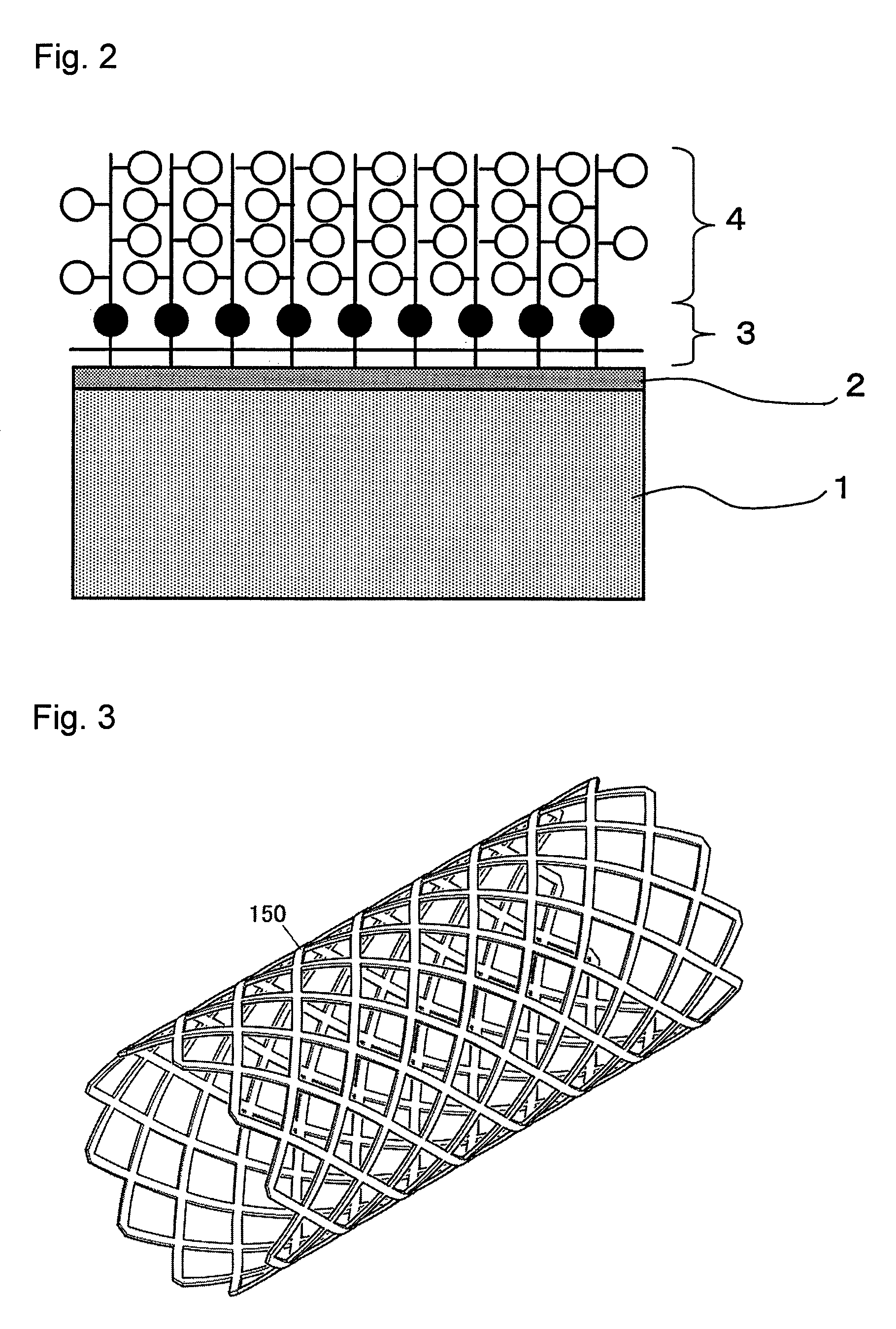Medical device and method for producing the same
a medical device and method technology, applied in the field of medical devices, can solve the problems of serious harm to the human body, large problem, and insufficient biocompatibility, and achieve the effects of reducing the risk of stroke, excellent antithrombotic properties, and inhibiting dental plaque deposition and periodontal diseases
- Summary
- Abstract
- Description
- Claims
- Application Information
AI Technical Summary
Benefits of technology
Problems solved by technology
Method used
Image
Examples
first embodiment
(First Embodiment)
[0051]FIG. 1(A) is a schematic sectional view showing a cardiac blood pump 101 according to the first embodiment of the present invention, and FIG. 1(B) is a plan view showing the cardiac blood pump 101. The cardiac blood pump 101 is used as a blood delivery pump in an artificial heart-lung apparatus. As shown in FIG. 1(A), the cardiac blood pump 101 according to the present first embodiment is provided with a pump casing 110, and an impeller 102 rotatably supported in the pump casing 110. The impeller 102 includes a conical rotor 121 and a shaft 120 thereof, and plural fins 122 facing towards the casing inner surface are disposed on a conical surface of this rotor 121 in a centrifugal direction. In the vicinity of the top portion of the casing 110, an inlet port 141 of blood communicating with the top portion of the rotor 121, and an outlet port 142 of blood communicating with the bottom portion of the rotor 121 is disposed at an outer periphery side of a bottom p...
second embodiment
(Second Embodiment)
[0086]Subsequently, a dental implant according to the second embodiment of the present invention will be described in detail below with reference to FIGS. 6 to 8.
[0087]FIG. 6 is a perspective view of an artificial dental root 1 according to one embodiment of the present invention. FIG. 7 is a sectional view of the artificial dental root 1 shown in FIG. 6, and FIG. 8 is an exploded view of the same.
[0088]As shown in FIG. 8, an artificial dental root 201 consists of a fixture 202, an abutment 230 and an abutment screw 240, and this corresponds to the substrate 1.
[0089]It is possible to use, as the material of the artificial dental root 201, known materials, for example, metallic materials such as titanium, a Ti alloy, a Co—Cr alloy and a molybdenum alloy, and ceramic materials such as alumina ceramics.
[0090]The fixture 202 consists of two elements such as a base body 210 and an interdental papilla forming body 220. The external surface of the base body 210 and the i...
example 1
[0101]A cardiac blood pump according to the present invention was produced in the following manner. A Co—Cr—Mo alloy with the composition of Co-28Cr-6Mo was used as the material constituting a substrate. Silica was used as the material of a binder layer and MPC was used as a biocompatible material.[0102](1) First, a cardiac blood pump made of a Co—Cr—Mo alloy (composition: Co-28Cr-6Mo alloy) was formed by a conventional method and the resulting cardiac blood pump was subjected to ultrasonic cleaning in an acetone solution.[0103](2) Then, the cardiac blood pump was subjected to a high Cr treatment (nitric acid treatment) by dipping in a 20 to 40% nitric acid for 30 minutes.[0104](3) This cardiac blood pump subjected to the nitric acid treatment was placed in a plasma treatment apparatus and subjected to an oxygen plasma treatment for 5 minutes to form an oxide on a surface, and then high-density Cr—OH was formed.[0105](4) The treated cardiac blood pump was quickly dipped in an ethano...
PUM
| Property | Measurement | Unit |
|---|---|---|
| thickness | aaaaa | aaaaa |
| contact angle | aaaaa | aaaaa |
| thickness | aaaaa | aaaaa |
Abstract
Description
Claims
Application Information
 Login to View More
Login to View More - R&D
- Intellectual Property
- Life Sciences
- Materials
- Tech Scout
- Unparalleled Data Quality
- Higher Quality Content
- 60% Fewer Hallucinations
Browse by: Latest US Patents, China's latest patents, Technical Efficacy Thesaurus, Application Domain, Technology Topic, Popular Technical Reports.
© 2025 PatSnap. All rights reserved.Legal|Privacy policy|Modern Slavery Act Transparency Statement|Sitemap|About US| Contact US: help@patsnap.com



